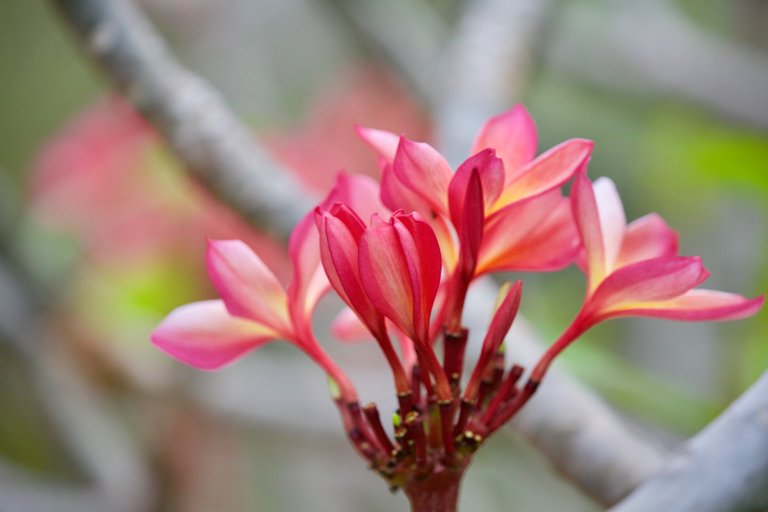
Did you know that there are over 300 varieties of Plumeria! These I photographed inside of Kokohead Crater, Ohau Hawai'i. I like to bring the flowers home and place them on my window sill. The fragrance is one is light yet pleasant and the colors from pink to a light orange bring such vibrance to the space. I wish you could see and smell them personally.
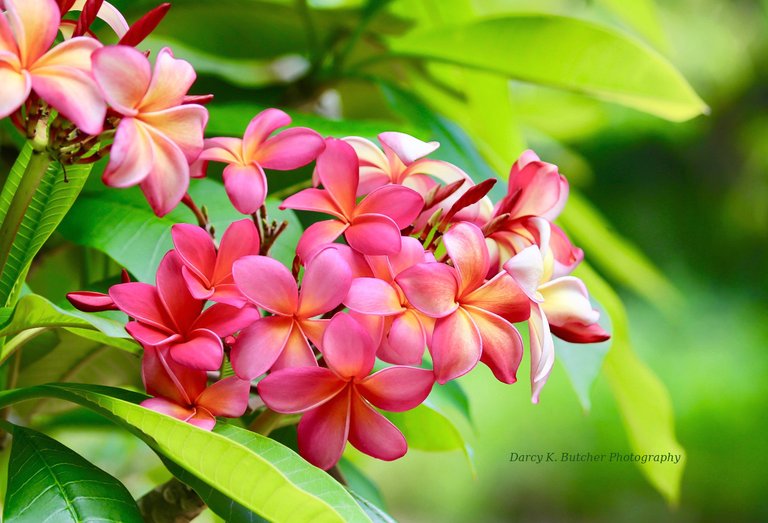
The plumeria flower’s sweet fragrance and vibrant colors make it one of Hawaii’s most iconic symbols. It is used extensively in making leis. Whether you wear the pua melia (Hawaiian for plumeria flower) around your neck as a lei, up in your hair as an adornment, or over your ear to indicate your relationship status (over your left ear means you are “taken” and over your right ear means you are “available”), be sure to experience the beauty and fragrance of this Hawaiian flower.
The indulgent scent and beauty of the plumeria can be captured in plumeria-shaped scented floating candles, luxurious body lotions, and even elegant island jewelry. These items make great souvenirs and gifts. One of the most valuable incense purchased is Nag Champa which mingles plumeria and sandalwood scents. It gives a sweet, exotic and empowering support to most any environment.
Plumeria are not native to Hawaii. They were brought here in 1860 by a German botanist. The exotic, introduced flower thrived in Hawaii’s warm climate and volcanic soil, giving rise to the plethora of wonderful varieties born in Hawaii: the magnificent Royal Hawaiian, the deep crimson Hilo Beauty, and the sunset colored Lei Rainbow just to name a few.
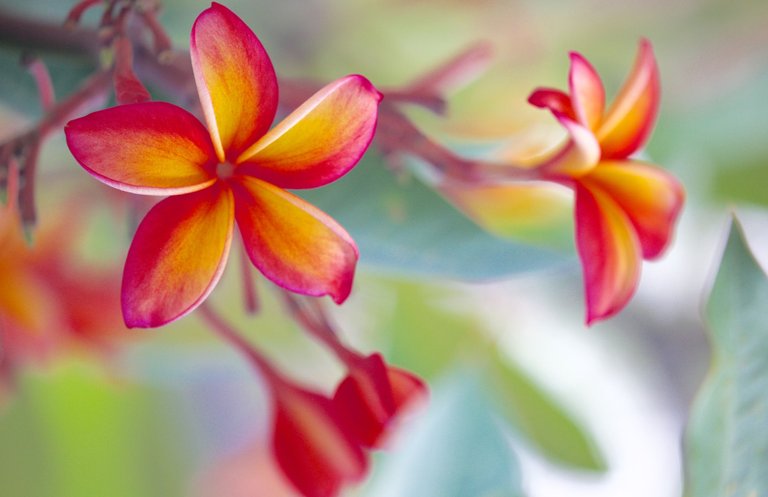
Additional Facts:
(thank you Wikipedia)
FRANGIPANI
- Plumeria (/pluːˈmɛriə/) is a genus of flowering plants in the dogbane family, Apocynaceae.
-Most species are deciduous shrubs or small trees. The species variously are indigenous to Mexico, Polynesia, Central America, and the Caribbean, and as far south as Brazil, but are grown as cosmopolitan ornamentals in warm regions.
-Common names for plants in the genus vary widely according to region, variety, and whim, but frangipani or variations on that theme are the most common. Plumeria also is used directly as a common name, especially in horticultural circles.
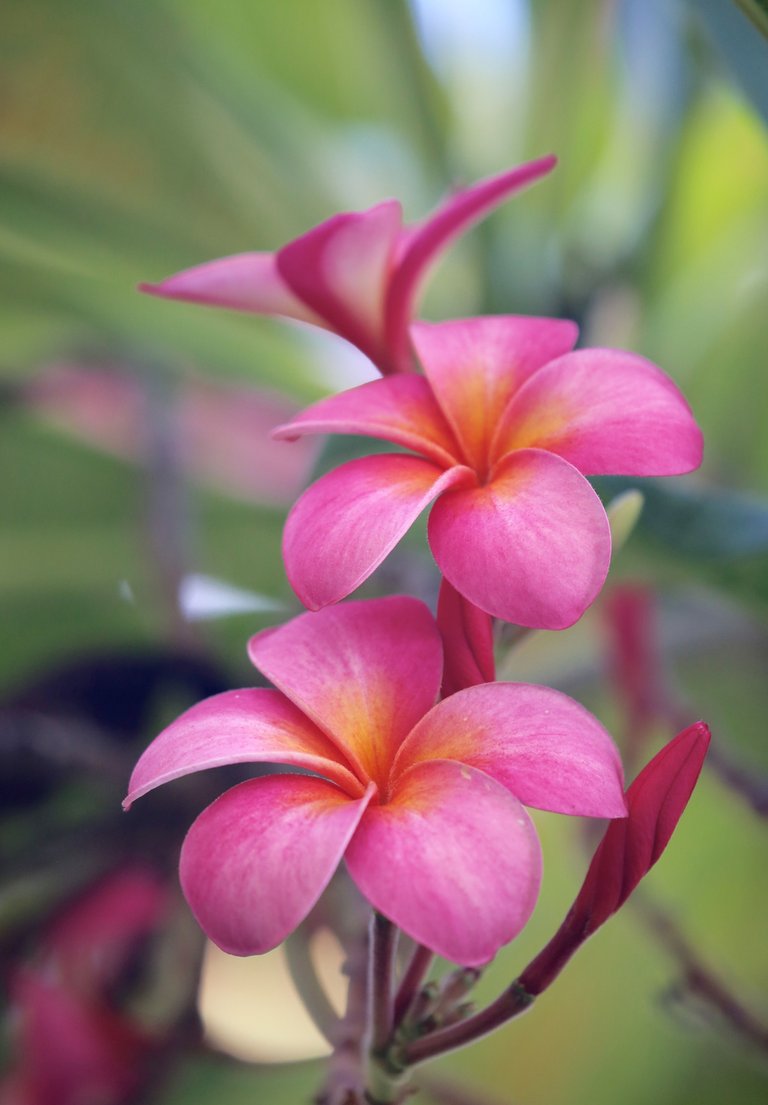
The genus Plumeria includes about a dozen accepted species, and one or two dozen open to review, with over a hundred regarded as synonyms.
Plumeria species have a milky latex that, like many other Apocynaceae contains poisonous compounds that irritate the eyes and skin. The various species differently in their leaf shape and arrangement. The leaves of Plumeria alba are narrow and corrugated, whereas leaves of Plumeria pudica have an elongated shape and glossy, dark-green color. Plumeria pudica is one of the everblooming types with non-deciduous, evergreen leaves. Another species that retains leaves and flowers in winter is Plumeria obtusa; though its common name is "Singapore," it is originally from Colombia.
In Mesoamerica plumerias have carried complex symbolic significance for over 2000 years, with striking examples from the Maya and Aztec periods into the present. Among the Maya, plumerias have been associated with deities representing life and fertility, and the flowers also became strongly connected with female sexuality. Nahuatl speaking people during the height of the Aztec Empire used plumerias to signify elite status, and planted plumeria trees in the gardens of nobles.
These are now common naturalised plants in southern and southeastern Asia. In local folk beliefs they provide shelter to ghosts and demons. The scent of the plumeria has been associated with a vampire in Malay folklore, the pontianak; frangipani trees are often planted in cemeteries. They are associated with temples in both Hindu, Jain, and Buddhist cultures.
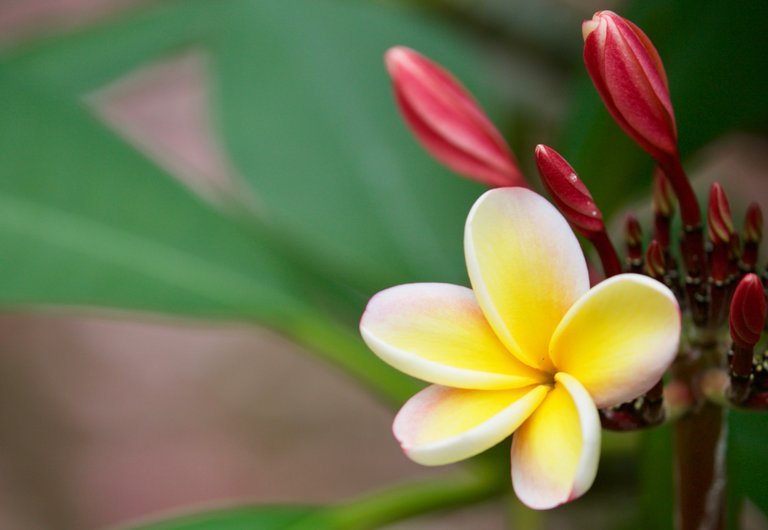
Yellow colors have the strongest fragrance.
In several Pacific islands, such as Tahiti, Fiji, Samoa, Hawaii, New Zealand, Tonga, and the Cook Islands plumeria species are used for making leis.[14] In modern Polynesian culture, the flower can be worn by women to indicate their relationship status—over the right ear if seeking a relationship, and over the left if taken.
Plumeria rubra is the national flower of Nicaragua, where it is known under the local name "sacuanjoche" and plumeria alba is the national flower of Laos, where it is known under the local name champa.
In some Bengali culture most white flowers, and, in particular, plumeria (Bengali, চম্পা chômpa or চাঁপা chãpa), are associated with funerals and death. In the Philippines and Indonesia, plumeria, which is known in Tagalog as Kalachuchi or Kalatsutsi (Plumeria acuminata), often is associated with ghosts and graveyards. Plumerias often are planted on cemetery grounds in both countries. They are also common ornamental plants in houses, parks, parking lots, etc. in the Philippines. Balinese Hindus use the flowers in their temple offerings.
In Malaysia, the plumeria's scent is known to be associated with the pontianak.
Indian incenses fragranced with plumeria rubra have "champa" in their names. For example, Nag Champa is an incense containing a fragrance combining plumeria and sandalwood. While plumeria is an ingredient in Indian champa incense, the extent of its use varies between family recipes. Most champa incenses also incorporate other tree resins, such as Halmaddi (Ailanthus triphysa) and benzoin resin, as well as other floral ingredients, including champaca (Magnolia champaca), geranium (Pelargonium graveolens), and vanilla (Vanilla planifolia) to produce a more intense, plumeria-like aroma.
In the dialect of Kannada spoken in the Old Mysore region of Karnataka of southern India, the flower is called Devaga Nagale. In the Western Ghats of Karnataka, the local people use cream colored plumeria in weddings. The groom and bride exchange plumeria garland at the wedding. It is alternatively called devaganagalu or devakanagalu (God's Plumeria). Red colored flowers are not used in weddings. Plumeria plants are found in most of the temples in these regions.
In Sri Lankan tradition, plumeria is associated with worship. One of the heavenly damsels in the frescoes of the fifth-century rock fortress Sigiriya holds a 5-petalled flower in her right hand that is indistinguishable from plumeria.
In Eastern Africa, frangipani are sometimes referred to in Swahili love poems.
Some species of plumeria have been studied for their potential medicinal value.
Hi! I am a robot. I just upvoted you! I found similar content that readers might be interested in:
https://en.wikipedia.org/wiki/Plumeria
Did you take any of these shots yourself? I like the close in style, very nice looking.
Yes these are my photos. Thank you! Most of these were taken inside of Kokohead Crater, Hawaii.